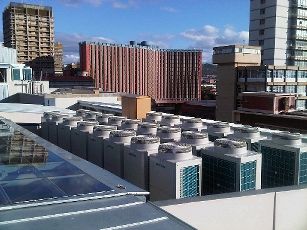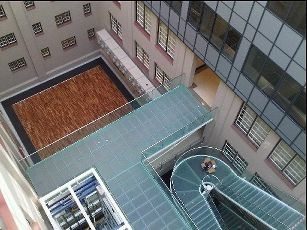The total area that required air conditioning solutions was approximately 26 000 m2. The system selected to undertake this task was the Mitsubishi Electric City Multi system, which we will explain in detail below.
The system summary is as follows:
For the past 30 years, Mitsubishi Electric Airconditioning Distributors have established themselves as a world-class brand in South Africa and are backed by ongoing research and development to meet the needs and comfort of the end-user.
With these goals and motives in mind, the City Multi brand was introduced as a sub-brand to the Mitsubishi Electric family of air conditioning equipment, offering remarkable innovations to suit various markets and their ever-changing requirements - from installation and space to electrical efficiency. The City Multi product has been well received internationally and has found phenomenal success here in Southern Africa.
The main feature of the product is its high energy saving capability. The City Multi systems consume approximately 40% less electrical energy compared to typical constant volume air conditioning systems available on the market today. This efficiency is achieved by using a combination of inverter technology and simultaneous heat recovery throughout the system.
Inverter technology relies on variably controlled inverter compressors and fan motors that are able to adjust their speed according to various demands put on the system during different peak loads at any given time.
For example, in common applications, most air conditioning systems will run at the maximum output when in operation. Once the desired temperature is reached it will switch off. As the temperature increases, the constant volume system will need to restart. In doing so, the system will need to draw a large amount of current in order to reach the desired temperature. Each time the system restarts, it draws amperages that are around six to eight times higher than the system’s running current, forcing the electrical demand curve to fluctuate during varying levels of operation. Depending on the number of individual systems you have as well as the continuous process of switching off and restarting again throughout the day, the demand for electrical power is increased.
Inverter technology does not rely on high energy consumption to start the compressor or the continuous on-off cycle explained above. Instead, the City Multi system turns on by drawing a very low 8 Amps of current. The system then gradually reaches its peak demand in order to get the compressor to its maximum output effectively without drawing high amperages. In other words, once the desired temperature in the space is achieved, rather than switching off, the compressor slows down, maintaining its set point without needing to restart each time the temperature rises or falls. This operation flattens out the electrical demand curve, resulting in lower energy consumption.
In addition to that, the biggest technological advantage the system has to offer is its ability to recover heat energy from certain areas when in cooling or heating mode. Generally, when an air conditioning system is in the cooling mode it will absorb the heat energy contained within the space it's trying to cool down by using the basic principles of refrigeration. Once this heat energy has been contained it will then reject the heat outside via an outdoor unit.
However, with the Mitsubishi Electric City Multi VRF system, we can recover this heat energy using the principles of reusable energy. For example, instead of rejecting the already warm air out of the area using the outdoor unit, the contained heat can be distributed and used to heat another part of the building. There are many applications today that need simultaneous heating and cooling including hotels, gyms as well as hospitals to name a few.
In summary, the Mitsubishi Electric VRF product line is able to simultaneously heat and cool different zones as well as heat water using one complete system; this is an industry first and unique to the Mitsubishi Electric brand.
Another significant advantage is that the City Multi VRF system is simple and flexible as was the case with this project. In the instance where a chilled water plant has reached the end of its usable life and needs to be replaced, the practicality and costs
of installing new water tanks and water reticulation piping can be a massive challenge in itself. However, with the City Multi products, the equipment is light and can easily be manoeuvred and installed into position. The use of light copper piping components when connecting indoor and outdoor units also helps to significantly reduce costs in materials and labour hours.
There are many more advantages to the Mitsubishi Electric product line including simple internet connectivity to off-site monitoring, making air conditioning management a seamless experience for service engineers, and building owners and or developers alike

